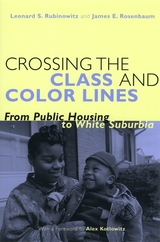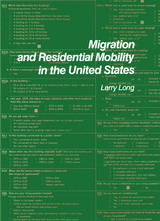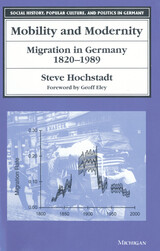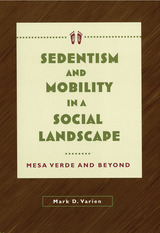4 books about Residential mobility

Crossing the Class and Color Lines
From Public Housing to White Suburbia
Leonard S. Rubinowitz and James E. Rosenbaum
University of Chicago Press, 2000
From 1976 to 1998, the Gautreaux Assisted Housing Program moved over 7,000 low-income black families from Chicago's inner city to middle-class white suburbs—the largest and longest-running residential, racial, and economic integration effort in American history. Crossing the Class and Color Lines is the story of that project, from the initial struggles and discomfort of the relocated families to their eventual successes in employment and education—cementing the sociological concept of the "neighborhood effect" and shattering the myth that inner-city blacks cannot escape a "culture of poverty."
"This book's history of Chicago public housing should be required reading for anyone interested in social policy in the United States."—Jens Ludwig, Social Service Review
"[The authors'] work is rightly cited as one of the important precedents in the field. . . . This is a remarkable, unassailable accomplishment and this book is an important record of their scholarly contribution."—John M. Goering, Ethnic and Racial Studies
"This book's history of Chicago public housing should be required reading for anyone interested in social policy in the United States."—Jens Ludwig, Social Service Review
"[The authors'] work is rightly cited as one of the important precedents in the field. . . . This is a remarkable, unassailable accomplishment and this book is an important record of their scholarly contribution."—John M. Goering, Ethnic and Racial Studies
[more]

Migration and Residential Mobility in the United States
Larry Long
Russell Sage Foundation, 1988
Americans have a reputation for moving often and far, for being committed to careers or lifestyles, not place. Now, with curtailed fertility, residential mobility plays an even more important role in the composition of local populations—and by extension, helps shape local and national economic trends, social service requirements, and political constituencies. In Migration and Residential Mobility in the United States, Larry Long integrates diverse census and survey data and draws on many academic disciplines to offer a uniquely comprehensive view of internal migration patterns since the 1930s. Long describes an American population that lives up to its reputation for high mobility, but he also reports a surprising recent decline in interstate migration and an unexpected fluctuation in the migration balance toward nonmetropolitan areas. He provides unprecedented insight into reasons for moving and explores return and repeat migration, regional balance, changing migration flows of blacks and whites, and the policy implications of movement by low-income populations. How often, how far, and why people move are important considerations in characterizing the lifestyles of individuals and the nature of social institutions. This volume illuminates the extent and direction, as well as the causes and consequences, of population turnover in the United States. A Volume in the Russell Sage Foundation Census Series
[more]

Mobility and Modernity
Migration in Germany, 1820-1989
Steve Hochstadt
University of Michigan Press, 1999
Mobility and Modernity uses voluminous German data on migrations over the past two centuries to demonstrate why conventional assumptions about the relationship between mobility and modernity must be revised.
Thus far the changing total volume of migration has not been traced over a long period for any country. Unique migration registration statistics, both detailed and broadly geographical in coverage, allow the precise plotting of migration rates in Germany since 1820. Steve Hochstadt combines careful quantitative methods, easily understood numerical data, and social analysis based upon broad reading in German social history to show that current beliefs about the direction and timing of changes in German mobility, which have been based on late nineteenth-century anxieties about urbanization and industrialization, do not match the data.
Migration rates in Germany rose continuously throughout the nineteenth century, and have fallen during the twentieth century. Mobility, Hochstadt argues, was not an unprecedented accompaniment to industrialization, but a traditional rural response to specific economic changes. Hochstadt's more precise analysis of urban in- and outmigration shows the mechanism of urbanization to have been the migration of families rather than the much greater, but also more circular, migration of single men and women.
Hochstadt demonstrates the importance of examining historical behavior, powerfully justifying the methods of historical demography as a path to social understanding. The data and specific conclusions are German, but the methods and reinterpretaion of migration history have much wider application, both to other modern European nations and to currently developing countries. Those who study the modern social history of Europe, the mechanisms that formed urban working classes, and the methods of historical demography will be interested in Hochstadt's work.
[more]

Sedentism and Mobility in a Social Landscape
Mesa Verde and Beyond
Mark D. Varien
University of Arizona Press, 1999
Research on hunting and gathering peoples has given anthropologists a long-standing conceptual framework of sedentism and mobility based on seasonality and ecological constraints. This work challenges that position by arguing that mobility is a socially negotiated activity and that neither mobility nor sedentism can be understood outside of its social context. Drawing on research in the Mesa Verde region that focuses on communities and households, Mark Varien expands the social, spatial, and temporal scales of archaeological analysis to propose a new model for population movement. Rather than viewing sedentism and mobility as opposing concepts, he demonstrates that they were separate strategies that were simultaneously employed. Households moved relatively frequently--every one or two generations--but communities persisted in the same location for much longer. Varien shows that individuals and households negotiated their movements in a social landscape structured by these permanent communities. Varien's research clearly demonstrates the need to view agriculturalists from a perspective that differs from the hunter-gatherer model. This innovative study shows why current explanations for site abandonment cannot by themselves account for residential mobility and offers valuable insights into the archaeology of small-scale agriculture.
[more]
READERS
Browse our collection.
PUBLISHERS
See BiblioVault's publisher services.
STUDENT SERVICES
Files for college accessibility offices.
UChicago Accessibility Resources
home | accessibility | search | about | contact us
BiblioVault ® 2001 - 2024
The University of Chicago Press









